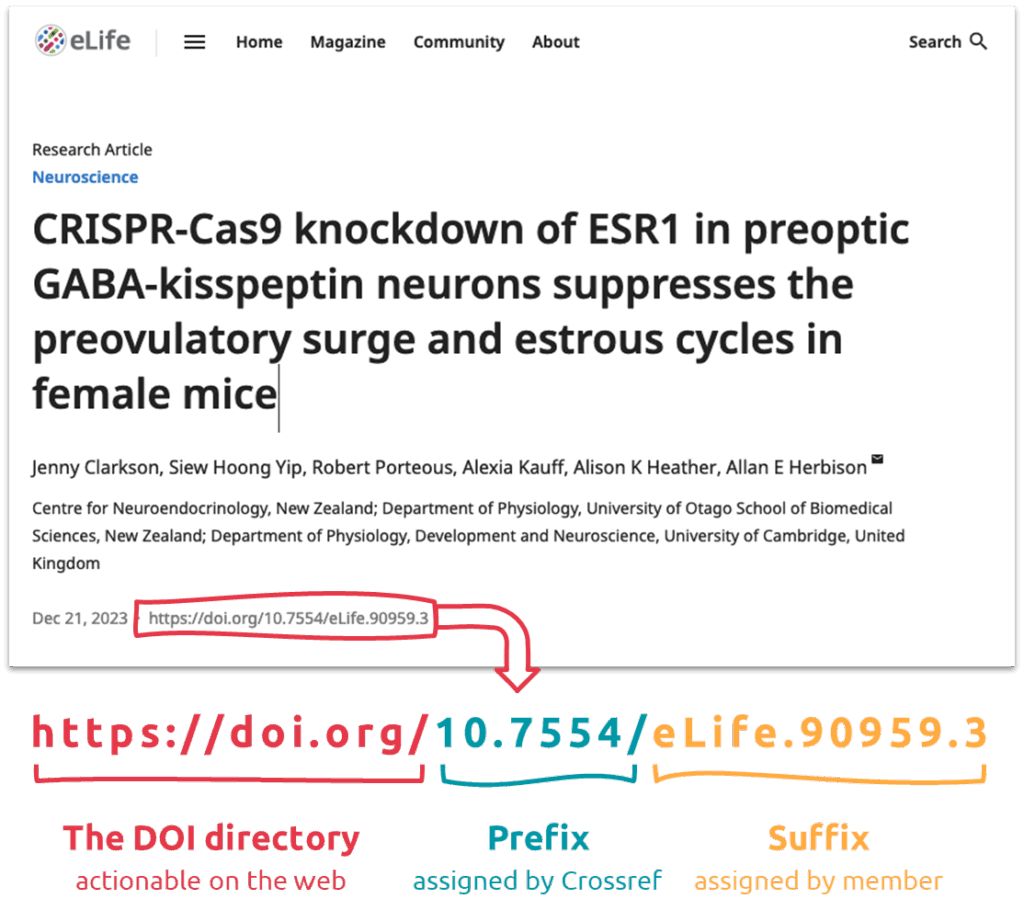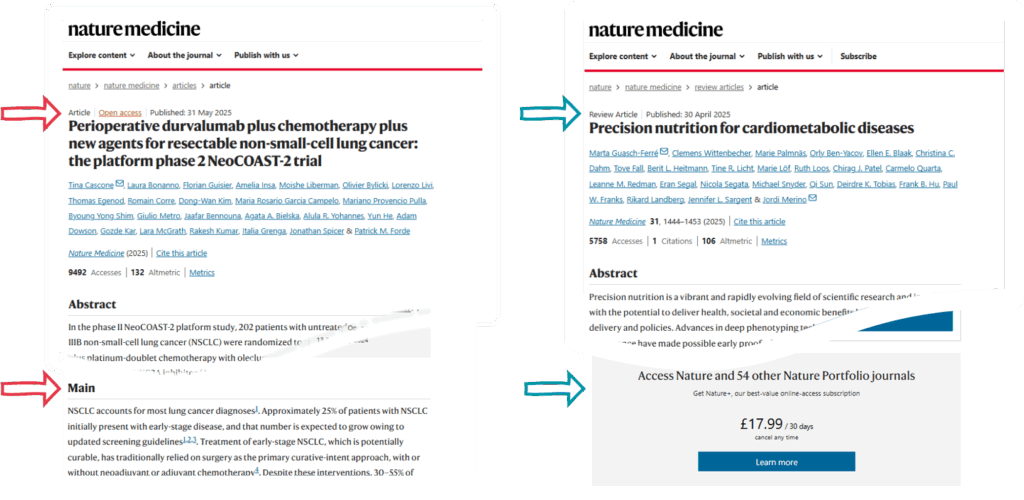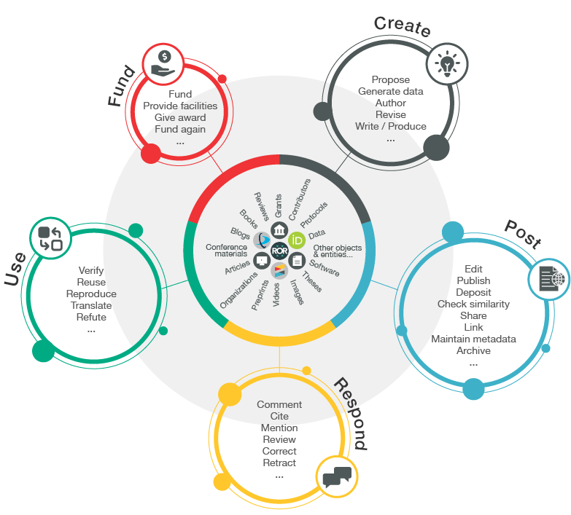Metadata of the DOI records registered with Crossref are a cornerstone of scholarly publishing, connecting research outputs through persistent, actionable links. In this post, I clarify what publication professionals need to know about Crossref DOIs and metadata; how they work, why they matter, and how they help make research more discoverable and accessible.
What is Crossref?
Crossref is a not-for-profit membership organization that exists to make scholarly communications better. We provide open digital infrastructure that enables our members – over 23 000 organizations from more than 160 countries – to register and share metadata about scholarly outputs.
As an agency of the DOI Foundation, we assign digital object identifiers (DOIs) to each of the 170 million research objects (e.g. books, journal articles, preprints and grants) in our database. Crossref operates the largest registry of scholarly DOIs, accounting for 94% of global DOI usage.
What is a Crossref DOI?
A Crossref DOI is a persistent identifier designed to uniquely identify scholarly objects. It is part of a global infrastructure designed to make research outputs easy to find, cite, assess and reuse thanks to the underpinning metadata. Importantly, Crossref DOIs are:
- public data – anyone can use them anywhere on the web
- actionable links – they should always be displayed as hyperlinks rather than plain text
- not markers of quality – a DOI does not imply endorsement or validation of the content it links to.
Crossref DOIs are public and can be used freely by anyone to link to scholarly content. Each DOI is associated with a landing page that must contain publicly available information describing the scholarly object.
Figure 1. Crossref DOIs are used to
identify specific digital objects and should
always be displayed as actionable links

As stewards of their records, Crossref members decide what information is made available on the landing page of each record. For subscription content, this may be limited to basic bibliographic details, abstracts and references, along with information about how to access the full-text content. This is an important distinction; the DOI is a reference to the object, not the object itself.
Figure 2. Crossref members are responsible for deciding the content that is visible on the object landing page.

Crossref members are responsible for maintaining a resolvable connection between the DOI and the object landing page. This ensures that the Crossref DOI always resolves to the correct scholarly object, even if the object moves or the publisher URL changes. This condition of Crossref membership supports transparency, discoverability and long-term access to scholarly content.
In short, a Crossref DOI is merely a persistent clickable reference to an object. It is not a marker of quality, although the metadata associated with each object can help individuals evaluate trustworthiness.
Why metadata matter
Each Crossref DOI record is underpinned by rich metadata – that is, data about data – including bibliographic details, author information (e.g. Open Researcher and Contributor iDs [ORCIDs]) and affiliations (i.e. Research Organization Registry [ROR] identifiers), funding sources, references and more, informing connections between records. Crossref’s metadata is queried nearly 2 billion times per month by thousands of systems, tools and people across the research ecosystem.
Figure 3. Crossref metadata have a range of
practical uses across the research ecosystem

Crossref metadata are open and reusable, and play a critical role in enabling the discovery, assessment and reuse of scholarly content. For example, as part of their membership commitments, Crossref members have an obligation to link the references within scholarly works using DOIs wherever possible. These links enable Cited-by, a service that allows researchers to easily identify related articles.
Figure 4. Crossref’s research nexus vision

Furthermore, the Crossref Grant Linking System allows publishers to associate funding metadata with scholarly records. Not only does this system support transparency and trust in research outputs, but enables funders to streamline impact evaluation of their research investments. These are just two examples of how the metadata captured by Crossref create links between research artifacts, supporting both discoverability and transparency in research communication.
To learn more about how to access and use Crossref metadata, visit the API learning hub.
Crossref’s commitment to openness
As a community-led initiative, Crossref is committed to the Principles of Open Scholarly Infrastructure. We believe in transparent governance, sustainable activities and open use of our systems. Our goal is to create a rich tapestry of metadata connecting research organizations, people, things and actions to allow the global research community to build on the scholarly record forever, for the benefit of society.
If you have any questions about how to use DOIs or metadata in your work, we encourage you to reach out to us through our community forum.
References
- Cascone T, Bonanno L, Guisier F et al. Perioperative durvalumab plus chemotherapy plus new agents for resectable non-small-cell lung cancer: the platform phase 2 NeoCOAST-2 trial. Nat Med 2025. https://doi.org/10.1038/s41591-025-03746-z.
- Guasch-Ferré M, Wittenbecher C, Palmnäs M et al. Precision nutrition for cardiometabolic diseases. Nat Med 2025;31:1444–53. https://doi.org/10.1038/s41591-025-03669-9.
The views expressed in this blog post are those of the author(s) and do not necessarily reflect those of Open Pharma or its Members and Supporters.
Kora Korzec is a Director of Community at Crossref, where she works with the scholarly communications community to support inclusive and active participation in the rich networks of connections weaved by metadata between people, organizations and scholarly works, dubbed Research Nexus by Crossref. Kora previously worked at eLife, promoting responsible research culture. Prior to that, Kora headed engagement activities for international development and education charity Engineers Without Borders UK.






